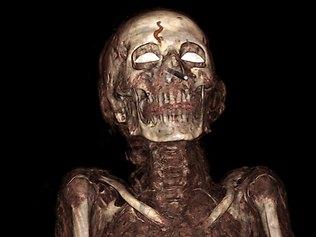Opening up antiquities from ancient Egypt and Mesopotamia
ACCORDING to its website (at the time of writing), the British Museum has five loan exhibitions touring across the world.

ACCORDING to its website (at the time of writing), the British Museum has five loan exhibitions touring across the world.
One is in North America (The Printed Image in China, 8th-21st Century, at the Metropolitan in New York), one in China (Passion for Porcelain: Masterpieces of Ceramics from the British Museum and the Victoria and Albert Museum, at the National Museum of China in Beijing) and one in Japan (Journey Through the Afterlife: The Ancient Egyptian Book of the Dead, at the Mori Arts Centre in Tokyo). Two, meanwhile, are in Australia: an exhibition devoted to ancient Mesopotamia in Melbourne and in Brisbane one, again, about that other great centre of early civilisation in Egypt.
In fact, the website includes details of even more exhibitions, including others that have not yet opened; one almost feels as though, as a curator or museum director, one could simply click and add them to one's shopping basket. Of course it is rather more complicated than that, but it is possible for an institution with the enormous depth of the British Museum to put together a range of exhibitions from its holdings and to tour them to a variety of venues internationally, especially as it is in a position to use these exhibitions as an opportunity to show off the results of new research. Such is the case with the Brisbane show, whose main focus is on one particular mummy and the remarkable new work that has been done on the study of the body inside it in a perfectly non-invasive way, by applying what was originally medical technology to archeology.
Because of the importance of the preservation of the body in ancient Egyptian religious belief, there were originally scores of millions of mummified cadavers; through the centuries, most of these have been destroyed, by ancient and modern tomb robbers, and even burned for fuel, while thousands were exported to Europe from the Middle Ages to the early modern period, to produce supposedly medicinal substances (French king Francois I took a dose daily) and for use in magic charms such as the one prepared by the witches in Shakespeare's Macbeth.
Even with the rise of a passion for Egyptology in the 19th century, a great many more mummies were destroyed by amateur or professional collectors. They were freely available for sale in Egypt, and Victorian gentlemen would have parties to unwrap - or, as they put it, unroll - their new acquisition. Often they would be opened simply to extract the amulets and other small objects, while the body itself was discarded.
In the past 100 years, fortunately, Egypt has enacted stringent laws to suppress tomb robberies, and the museums of the world have become much less cavalier about the unwrapping of mummies. The one that is the centrepiece of the Brisbane exhibition was acquired in 1899, together with its sarcophagus, by E. A. Wallis Budge, the author of, among other things, an important book titled The Gods of the Egyptians (1904), and has never been opened. In fact, it has not even been taken out of its inner coffin, which is made of cartonnage, a light shell composed of strips of linen and glue in a single form that encloses the wrapped mummy, and is joined at the back before being plastered and painted with sacred figures and emblems to protect the dead man in his journey to the next life.
The mummy was identified by Budge on the basis of the hieroglyphic inscription on the cartonnage coffin as Nesperennub, a priest in the Karnak temple complex in the 22nd Dynasty, about 800BC. Budge also acquired the sarcophagus of Nesperennub's father, but without its mummy, while the sarcophagus of his wife, Neskhonspakhered, now belongs to the Phoebe A. Hearst Museum in Berkeley, California. From the study of these and other inscriptions it is apparent that Nesperennub was part of a long line of priests and had married the daughter of another priest within the same cult.
In the 1960s, X-rays of the mummy allowed a first glimpse inside the wrapping, but large areas of opaque material limited the information that could be gleaned from these photographs. Since that time, however, the technology for non-invasive imaging has undergone a remarkable development. Computerised tomography scanning - the picturing of image slices, as the etymology suggests - yielded, in its earlier form, vastly improved results that were shown in an exhibition in 2004.
Since then, CT technology has grown far more sophisticated. The most up-to-date version allows multiple X-rays to be taken from various angles and at intervals of 0.6mm, so that when the images are digitally reassembled, they form a continuous picture in three dimensions.
The raw data is based solely on the relative density of the materials scanned, and appears in black and white; when they are processed and colourised, the results are almost breathtakingly vivid and minutely accurate pictures of what lies hidden inside the mummy's shroud. And future years should bring further improvements, so that one day we may be able to read with perfect clarity details, such as the tabs on the end of the priestly stolae around the figure's neck, that remain obscure today.
It is even possible, as we see in the short film presentation that opens the Brisbane exhibition, to present the data in the form of a fly-through video. For added verisimilitude, the film is in 3-D and the audience is issued with 3-D glasses. There is no doubt that it is exciting to be able to race up through the spinal column with the velocity of a toboggan ride, ending up in the cavity of the brain; and the whole thing is didactically effective, at least at a relatively simple level - the target audience seems to be older children and grown-ups with no prior knowledge of the subject - and underpinned by sound scholarship and new research.
Even so, there is something a bit disturbing about the assumptions that lie behind this kind of presentation. At the most obvious and general level, there is the populist, infotainment aspect, masked, as just noted, by the quality of the material being presented.
More specifically, though, a number of effects reflect the pervasiveness of computer games and the way they seem to be changing the manner in which people expect to be addressed, or even the way they think.
Thus making objects (like the prophylactic amulets included in the burial) rush towards us in 3-D space, on the face of it simply a gimmick, could have more serious implications. Audiences, it seems, now expect the image to come to them, rather than making the intellectual and imaginative effort of reaching out to it. The neutral passivity of television has been replaced with a more aggressive form of passivity disguised as interactivity.
The relation of subject to object, or the distinction between these terms, is dissolved as well - among other things by isolating the motif from its context, eliminating the ground, floating and rotating it in a disembodied space - so that instead of consciously looking at something outside ourselves, we are encouraged to imagine that we are actually witnessing things taking place in our own minds.
In the light of some of the deranged behaviour that has been in the news recently, the way such effects in computer games may be reshaping the brains of the less balanced of those who play them should be a matter for concern. After all, a minimal definition of sanity is to know the difference between what is only in our heads and what has an independent reality in the world outside.
The second British Museum loan exhibition, in Melbourne, which for reasons beyond my control I have not yet had the chance to see, deals with the other great centre of early civilisation, in the region known as Mesopotamia - the land between the two rivers, the Tigris and Euphrates.
Among the earliest people in this area were the Sumerians, whose ethnic origins are still obscure although we know they were neither Indo-European nor Semitic. But these mysterious people made some of the most momentous inventions in human history, namely the wheel (both for potting and for carts) and writing.
Civilisation, as we have mentioned recently, began with the domestication of cereal crops, which allowed more people to be fed in a reliable way, thus allowing greater concentrations of population and the establishment of cities, while requiring the labour of only a part of the population, freeing others to develop specialised trades. Fertile riverlands with a warm climate provided the most favourable conditions for this momentous change. The riverlands yielded clay for sun-dried bricks to build houses and temples, and for ceramics, which provided the vessels needed to store grain, oil, wine and other commodities.
After the infinitely slow progress of human material culture before the Neolithic Revolution, the beginning of civilisation was like a chain reaction in which one invention or new solution led to another.
Even writing emerged from the need to keep records of crops gathered in and dispensed to the community, and here again the riverlands provided the clay used for tablets and the reeds employed to impress the marks of the cuneiform writing system.
Cuneiform began, in about 3000BC, as a pictographic system and evolved into a complex semi-phonetic script that was still far harder to master than the alphabetic writing that was invented by the Phoenicians about 1000BC and evolved into the Hebrew script as well as the Greek and then the Roman ones. But it was an extraordinary leap forward for the human mind, adopted as the means of transcribing several languages, as well as stimulating the invention of alternative systems such as the Egyptian hieroglyphs.
Although recorded in a medium as seemingly impermanent as unfired clay, many of these cuneiform records have been preserved because of the dry environment of the Iraqi desert, and even the burning of sacked palaces served only to bake them into more durable form.
Later inscriptions were engraved in stone, in an elegant script that records the achievements and claims of the successive rulers of Mesopotamia, above all the Assyrians and the Babylonians - for many little more than shadowy presences looming over biblical history - and finally the Persians, with whom we arrive at the times first recorded by Greek historians, especially Herodotus.
Words and writing, and the history of Mesopotamia, are at the heart of this exhibition, but there are also examples of the magnificent relief sculpture of the Assyrians, vividly evoking their gods, the cruelty of warfare and, even, most dramatically, the royal practice of lion hunting, later emulated by Alexander the Great as a symbolic way of stating his claim as the legitimate monarch of the eastern empire.
Mummy: Secrets of the Tomb
Queensland Museum, Brisbane, until October 21
Wonders of Ancient Mesopotamia
Melbourne Museum, until October 7



